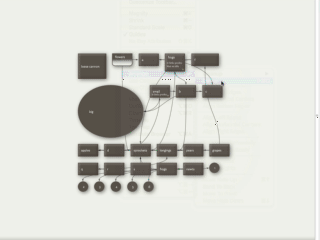Dancing

Tinderbox 7.5 can help disentangle messy link networks to make your maps easier to understand as they grow.
In essence, Tinderbox imagines that each link is a spring that pulls its notes closer together. If notes get too close together, they repel each other, while more distant notes attract each other. Tinderbox simulates the physics of this contraption, which can often improve layouts a lot. (This is called force-directed layout.)
A problem with this approach is that your layout can get caught in a local minimum — a bad layout, but one where each small change makes things even worse. To avoid this, each time we start dancing, Tinderbox gives your notes a gentle, random kick. This shake helps make sure that the machine finds a reasonable configuration. (This is called simulated annealing, by analogy with the metallurgical process where heating and forging iron helps strengthen the metal.)
Force-directed layout of graphs is fairly common, though I don’t recall its use in a hypertext tool before. Some of the details here are novel — in particular, the force between unlinked notes is based on the Van de Waal’s force that makes liquids cohere rather than fly off into gaseous clouds. I don’t know whether that improves the result, or makes it worse; I hope to find out.
Research finds help in unexpected places. In this case, I got a boost from an old GDC paper by Thomas Jakobsen on “Advanced Character Physics”. Jakobsen’s problem was creating better animations of the impact of bullets on bodies in first-person shooters, which is a long way from improving knowledge representation in notes! But in pursuit of his objective, he picked up on Verlet integration, a numerical integration method that was developed for molecular dynamics simulations in the 1960s by Loup Verlet. (Remember what I said about Van der Waal’s forces? Small world.). That turns out to be very helpful.
This is not a panacea: really tangled link networks, like Mary-Kim Arnold’s “Lust”, stay tangled. It’s a handy expedient to try when your intellectual office gets cluttered.